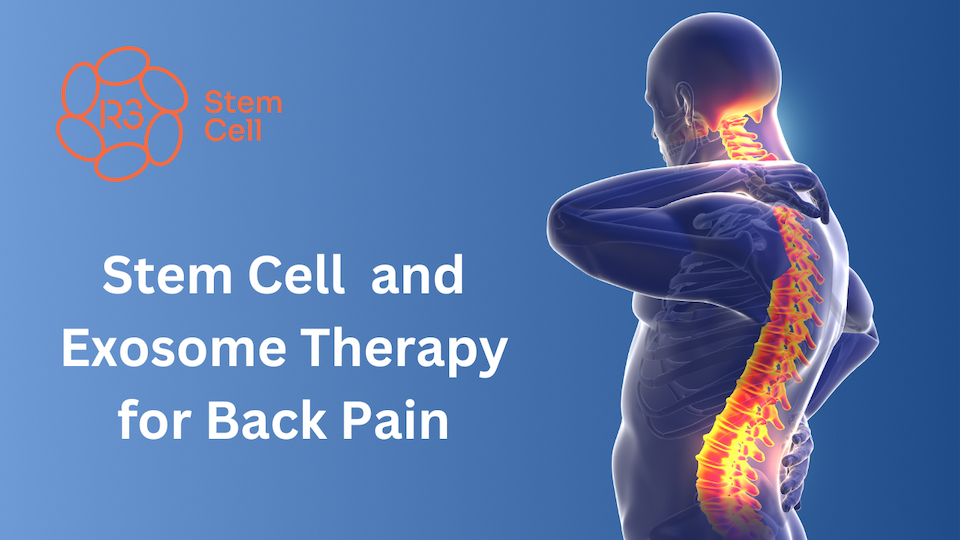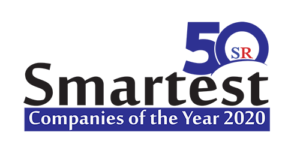The US Leader is NOW in Mexico. Procedures ONLY $3750 for 25 million stem cells!
NEW PROMO: Treatments > 50 million cells receive FREE 25 BILLION Exosomes IV!*
The US Leader is NOW in Mexico. Procedures ONLY $3750 for 25 million stem cells!
NEW PROMO: Treatments > 50 million cells receive FREE 25 BILLION Exosomes IV!*

Every day, R3 Stem Cell receives inquiries worldwide from individuals asking if stem cell therapy can help for back pain. Spoiler alert: It can help a lot! In this guide, we’ll go through the basics of how stem cells and exosomes work for relieving back pain long term, the latest research, and what to expect with a regenerative procedure.
Back Pain is Everywhere
Chronic low back pain, defined as pain symptoms persisting beyond 3 months, affects an estimated 15–45% of the population. Back pain has been termed as “an illness in search of a disease.” For the minority who suffer from intractable symptoms, quality of life may suffer tremendously.
During life, over 80% of individuals will experience low back pain, and for an unfortunate few it becomes chronic.
In 2020, low back pain (LBP) affected 619 million people globally and it is estimated that the number of cases will increase to 843 million cases by 2050, driven largely by population expansion and aging (World Health Organization). LBP is the single leading cause of disability worldwide.
Chronic LBP is a major cause of work loss and participation restriction and reduced quality of life around the world. Considering the high prevalence, LBP contributes to a huge economic burden on societies. It should be considered a global public health problem, virtually an epidemic.
Close to 90% of those suffering from back pain do not have a definitive anatomical correlation, and the pain remains nonspecific. In essence the following sources of back pain are combined as “one” to define lumbar spondylosis: (i.e. symptomatic disc degeneration, symptomatic facet joint osteoarthritis and segmental instability). We will use the term Low Back Pain moving forward to include the combined sources.
The tremendous impact of low back pain was portrayed in a prospective multicenter study including 8 industrialized countries which found that patients with chronic spinal conditions have lower quality of life scores when compared with patients with other chronic conditions such as arthritis, chronic lung disease, congestive heart failure, and diabetes.
Stem cell therapy for low back pain is turning out to be an excellent opportunity for individuals to regain a pain free life, improve function, avoid surgery, avoid pain medications, and get back to a quality of life you deserve. Read on to learn more.
Current Nonsurgical Options
Current non-surgical options to manage low back pain include exercise and physical therapy, weight loss, NSAIDS, TENS Units, bracing, traction, manipulation, massage, opioids, antidepressants, topical medications and muscle relaxants.
Various types of injections for the low back have been employed, including epidural steroid injections, facet or medial branch blocks, and radiofrequency ablation.
Steroids, although they present a good anti-inflammatory action, tend to destroy Facet cartilage at the same time. That is why when their action has stopped, the pain gets worse than before. Opioids are not a great option for chronic back pain. They have significant side effects such as constipation, tolerance and possibly addiction.
These injections and medications are not meant to repair or regenerate degenerative spinal tissues, but rather to mask pain for a period of time. In order to potentially change the narrative for nonsurgical treatment approach for lumbar spondylosis, umbilical cord allograft tissue may represent a safe and clinically effective option for achieving pain relief.
Researchers have evaluated perinatal allogenic tissues including clinical-grade minimally manipulated umbilical cord tissue-derived allograft, and reported on the significant presence of growth factors, cytokines, hyaluronic acid and exosomes.
Spinal Fusion for Low Back Pain
Despite the existence of sophisticated imaging techniques and a plethora of diagnostic testing, the source of pain in patients with nonspecific back pain cannot be established. There exists no causal relationship between imaging findings of degenerated disc, lumbar facet arthritis, spondylosis, spondylolysis and spondylolisthesis, to the pain in these patients.
Spinal fusion is a major surgery which can be associated with significant morbidity and occasionally with mortality. Is there justification for spinal fusion in the treatment of patients with non-specific low back pain?
Fairbank et al, in 2005, published the results of a randomised controlled trial which assessed the clinical effectiveness of spinal stabilization or fusion compared to intensive rehabilitation for patients with chronic low back pain. Their cohort included 349 patients between the ages of 18 to 55 years with at least one year of low back pain who were considered by an experienced surgeon that they were candidates for spinal fusion.
There were surgical complications in 19 patients. Eleven patients in the surgical group had reoperations. Complications included dural tears, excessive bleeding, implant problems, fractures and vascular injury.
The study showed that there was no clear evidence that primary spinal fusion surgery was any more beneficial than intensive rehabilitation in patients with chronic low back pain. Surgery while not having any superiority over conservative management was associated with potential risk and increased cost.
In a study by Fritzell et al (2001) comparing surgical with non-surgical treatment for low back pain 18% of the patients in the fusion group developed early (within 2 weeks) complications and 6% had late complications. Complications included, bleeding, neural injury, heart failure, major GI bleeding, pulmonary oedema, aspiration sepsis, pulmonary embolism, dural tears, haematomas, pseudoarthrosis and even wrong level surgery. In patients who had complex fusion the complication rate was 31%. The reoperation rate in the surgical group was 6%.
Despite a lack of superiority of spinal fusion over non-operative treatment of patients with chronic non-specific low back pain, there has been a steep rise in the rates of spinal fusion over the last two decades.
Since having a spinal fusion is an elective procedure, patients should truly try all beneficial conservative options prior to making the surgical decision.
Research on Stem Cell Therapy for Back Pain
In 2024, Wilson et al evaluated exosome injections for low back pain. Twenty adult subjects with lumbar facet joint pain received a single injection of mesenchymal stem cell derived extracellular vesicles in the lumbar facet joint space. By the 3-month end point, follow-up was successful, and no complications or adverse events were noted. Significant improvements in all assessments of pain and disability occurred throughout the study.
In 2023, Sharan et al published the first human case report of umbilical cord mesenchymal stem cell injections for both cervical and lumbar being injected into the epidural and facet joint spaces. A 47-year-old male presented with complaints of 13-year-long chronic lower back pain resistant to conservative treatment. The decision was made to treat the patient with umbilical cord-derived mesenchymal stem cells (MSCs). Eighty seven million MSCs were infused intravenously.
Simultaneously, 1 million cells were injected into each of the 8 lumbar epidural facet joints and 5 million cells into the lumbar epidural space. The patient had no adverse events or complications related to the treatment. Five days after treatment, most of his lumbar pain was gone, and his back spasms stopped. He no longer needed to take acetaminophen or ibuprofen and had no difficulty sleeping without medications. The patient also reported his residual cervical radicular pain to be 98% resolved due to the injection. The authors noted the exceptional pain relief achieved with “discogenic” back pain, but without injecting intradiscal.
In a prospective study evaluating bone marrow stem cell injections for low back pain versus steroid injections, Atluri et al evaluated 44 patients, half of whom received the stem cells.
The treatment group patients received a one-time bone marrow concentrate injection
into spinal structures (i.e., discs, facets, spinal nerves, and sacroiliac joints), along with conventional treatment, whereas, the control group received conventional treatment with nonsteroid anti-inflammatory drugs, over-the-counter drugs, structured exercise programs, physical therapy, spinal injections and opioids, etc., as indicated.
Typically, the stem cells were injected in each disc (2 mL), epidural space (2 mL), facet joints (0.5 mL), and sacroiliac joint (1 mL). Significant improvement in mean pain scores from 7.1 ± 2.2 to 4.2 ± 2.8 with significant difference in pain scores from baseline to all follow up periods.
At the end of the study period (12 months), among 22 patients in the treatment group, 8 patients did not require opioids and 9 patients decreased opioid use. An amazing 77% of patients in the investigational group either stopped or decreased opioids compared to none in the control group. In contrast, all patients in the control group remained on opioid therapy throughout the study period.
The results of this study showed significant improvement in function and pain relief in 67% of the study group The authors concluded, “It appears that stem cell therapy could be a reasonable option to treat chronic low back refractory to conventional treatment, especially
if performed by qualified physicians following the proper guidelines”.
Adipose stem cells were used by Rothoerl et al in Thirty-seven presenting with low back pain between the ages of 31 and 78. After one week, patients already reported an improvement reflected by a decreased Visual Analog Scale pain level. At the one-year follow-up the mean VAS level was 1.5, and the mean ODI was 17.5%. At the five-year follow-up, the mean VAS level was 1.4, and the mean ODI was 18.7%. Every patient reported improved VAS pain after treatment with ADRCs compared to the baseline. This result was observed in the short term (one week and one month) and in the longer term after five years of follow-up.
In one prospective study, 33 patients with lower back pain and disc degeneration were treated with culture-expanded, autologous, mesenchymal stem cells with follow-up period up to 6 years. The study of intradiscal injections has proven safety with only minor adverse events and significant improvements in pain, function, and overall subjective improvement as evidenced by numeric pain score (NPS), modified single assessment numeric evaluation (SANE) rating and functional rating index (FRI). Measurement of the intervertebral disc posterior dimension has shown that 85% of the patients who were evaluated by MRI demonstrated a reduction in disc bulge size, with an average reduction size of 23% post treatment.
A Chinese study in 2014 evaluated two patients receiving umbilical cord stem cell injections intra-discal for chronic low back pain. After transplantation, the pain and function improved immediately in the 2 patients. The VAS and ODI scores decreased significantly during a 2-year follow-up period.
It has become apparent from the numerous studies reported on intra-discal stem cells that pain relief occurs, but rehydration of the disc does not. Many studies have concluded that transplanted cells could not survive in the hypoxic environment of the disc. Likewise, various inflammatory mediators, the low pH, low glucose levels, and hyperosmolarity present in the degenerated disc may disturb the function of transplanted MSCs.
For the most part, R3 Stem Cell performs stem cell injections into the epidural space, facet joints and in the paraspinal musculature for patients with chronic low back pain. This has worked unbelievably well for those dealing with spinal stenosis, discogenic pain, arthritis or scoliosis pain.
In addition, an IV stem cell therapy works exceptionally well for helping with back pain as a combination therapy. Stem cells travel through the bloodstream and are attracted to areas of inflammation. All arthritis, stenosis, disc disease and nerve root compression includes arthritis. So the stem cells applied intravenously will also reach the area and provide repair, regeneration and relief!
Stem Cells can also release a huge variety of molecules into the extracellular environment. These molecules, which include extracellular vesicles (exosomes), lipids, free nucleic acids, and soluble proteins, exert crucial roles in repairing damaged tissue. Along with offering stem cells for back pain relief, R3 Stem Cell includes stem cell exosomes, which are a type of extracellular vesicle participating in extensive cell to cell communication for tissue repair and regeneration.
The stem cells administered by R3 are not the ones that become a patient’s new specialty cells. The administered mesenchymal stem cells are not specifically designed to replace damaged and lost cells “themselves”, but rather coordinate and enhance this repair response by one’s own mechanisms.
Where do the stem cells and exosomes come from?
R3 Stem Cell’s regenerative biologics originate from umbilical cord tissue that has been donated after a scheduled c-section. No baby (or mother) is harmed during the c-section procedure. The umbilical cord tissue is normally discarded, but if the mother passes screening test then the umbilical cord is immediately sent to the lab.
The lab carefully processes the umbilical cord to generate large amounts of stem cells and exosomes that are of the highest quality possible. The lab team consists of multiple PhD’s working in ISO Certified, cGMP compliant clean rooms to ensure quality assurance that exceeds USA FDA standards. The proprietary production process combines the highest potency, safety and affordability for providers to confidently offer exosome procedures.
Millions of dollars have been invested into the pharmaceutical grade production of the biologics including first rate clean rooms, bioreactors, nano-particle tracking analyzers, cytometers, PCR, tangential flow machines and real time environmental monitoring. The quality assurance testing complies with screening and testing standards consistent with the American Association of Tissue Banks, cGMP standards, FDA regulations and the highest level of any regulatory agency globally.
Stem Cell Derived Exosomes
R3 Stem Cell’s Centers of Excellence globally include umbilical cord stem cell derived exosomes with umbilical cord stem cells to provide enhanced results. Exosomes are lipid bound vesicles (acellular) produced by cells which contain a plethora of growth factors, cytokines, mRNA and other proteins.
They are exceptionally helpful in cell to cell communication, and very effective for reducing inflammation when they become ingested by their recipient cell. They act as shuttles to send nucleic acids and proteins to other cells, in this way, allowing cell-to-cell communication and transporting molecules among both close and distant cells. In general, these released proteins are important regulators of intracellular information.
Exosomes could be the mediators of many stem cell-associated therapeutic activities. Considering they are 100 times smaller than stem cells, they do not have any issues passing through the blood-brain-barrier to reach the brain from the bloodstream.
What is the role of exosomes in back pain?
Previous reports have confirmed the cell-protective effects of exosomes in the heart, skin, and skeletal muscle diseases. Recently, the role of exosomes in reducing oxidative and nitrosation damage has attracted a lot of attention.
Numerous studies have evaluated the antioxidant effects of exosomes in different disease models, such as the damage caused by hyperglycemia and obesity, alcohol-related brain damage, Parkinson’s disease, musculoskeletal diseases (e.g., intervertebral disc degeneration (IVDD), radiation-induced bone loss, osteoarthritis (OA)), liver injury, ischemia injuries, colitis and skin wounds. Further, exosomes can directly alleviate oxidative stress in various types of cells such as glial cells, neurons, cardiomyocytes, endothelial cells, immune cells, hepatocytes, and nucleus pulposus cells in vitro.
Oxidative stress plays a key role in the pathophysiology of many diseases, by causing cell damage, inflammation, and metabolic disorders. In all living cells, similar components are
responsible for mediating excessive oxidative stress and unbalanced reduction. Therefore, exosomes can regulate these molecular components which can be used to treat different diseases.

So what back pain disorders does R3 Stem Cell treat?
The beneficial effects of mesenchymal stem cells and exosomes are seen for all types of back pain conditions including:
Here are the benefits we see frequently:
Is stem cell therapy safe?
After a decade of performing over 24,000 stem cell procedures worldwide, R3 knows that the regenerative procedures are safe. The quality control employed during the stem cell production is second to none, and the side effects R3 sees are usually mild to moderate and temporary.
They may include itching, dizziness, lightheadedness, low grade fever, chills, headache, nausea. These are typically temporary. If a patient has an allergic reaction to the multivitamin or a preservative, all of R3’s Centers have the medications to resolve it quickly.
One of the questions we get asked a lot is, “Will the stem cells get rejected?” The answer is NO.
MSCs do not express major histocompatibility complex (MHC) antigens of the class II subtype and contain low levels of MHC molecules of the class I subtype. MSCs also lack the co-stimulatory molecules essential for immune detection, including CD40, CD80, and CD86.
Therefore, MSCs generally have low immunogenicity and can avoid immune rejection by the recipient, which serves as the foundation for their successful application without needing to match the donor to the recipient. Scientists call this being “immunologically privileged”.
Another question often asked is “Is there a chance of a tumor forming?” Once again the answer is NO. The mesenchymal stem cells and exosomes used during treatment have never been shown to have tumor forming potentials. In fact, they have been shown to be anti-tumor forming.
Treatment Protocol
For the past decade, R3 has been successfully offering stem cell and exosome therapy intravenous for all types of back pain. The cells and exosomes are attracted to inflammation, which is a large component of all types of back pain conditions such as disc disease, spinal arthritis, stenosis, sciatica.
R3’s providers use between one million stem cells per kilogram up to three million stem cells per kilogram. Why such a variable amount? The reason is patients are different! Some are very healthy, take no medications and are lean.
Others have multiple chronic diseases, drink alcohol, smoke cigarettes, etc. We’re not here to judge, just want to make sure enough cells are provided to obtain the desired effects. So our providers use judgment on the cell quantity needed.
Safety is paramount with the biologics products being rigorously tested prior to use, and expert providers managing each treatment as if you are a family member!
Why does R3 Stem Cell use donor tissue for its stem cells?
Although autologous (your own) stem cells provide significant advantages, allogeneic (donor) stem cells have more advantages. First of all, autologous MSCs need a long time to culture and expand, which limits its application in treatment, while allogeneic stem cells can be obtained and expanded more quickly, thus avoiding the delay of time window.
Second, age is a factor that affects the physiological characteristics of MSCs. Studies have shown that stem cells from elderly donors have decreased proliferation and differentiation ability. This means they are less in number and less effective!
What are the Outcomes?
Similar to the research mentioned above, R3 Stem Cell’s outcomes for all types of back pain have been exceptional! The patient satisfaction rate is 85% year over year. Patients typically see exceptional pain relief, increased range of motion, improved function and mobility, and all of the benefits mentioned above.
Wouldn’t it be fantastic to get off opioids? Avoid the need for a back surgery or obtain relief after a failed back surgery?
It may take four to six weeks for the results to kick in, although we have had patients symptomatically feel much better within the first couple of weeks. It should be noted, again, that stem cell therapy is not a “one and done” procedure, and may need to be repeated every one to three years.
Affordability
Because stem cell therapy is not a “one and done” cure, it’s important to make it affordable. Repeat therapies every 1-3years can help people achieve continued improvements. So a lot of patients seek additional back pain treatments at R3 Stem Cell repetitively.
Unfortunately, stem cell clinics in Colombia, China and Panama charge over $15,000 USD for back pain treatment. Because the one treatment cost so much, how are individuals supposed to budget for that every few years?? R3 Stem Cell’s fees are less than half that for full treatment, which also includes free PRP and a multivitamin infusion!
R3’s Experience
For the past decade, R3 Stem Cell’s Centers globally have performed over 24,000 regenerative procedures in six countries. Thousands have been for back pain. Patient satisfaction across all conditions treated is 85%!
R3 combines safety, effectiveness and affordability for the therapies. Internationally, the Intellicell is used, which is culturing the most active mesenchymal stem cells to create the “smartest” stem cell in the world!
Our experience with all types of patients has been extensive, and our Success Stories on R3’s YouTube Channel are impressive.
R3 Stem Cell offers free consultations for individuals to discuss whether regenerative therapy is indicated for you. Simply call +1 (844) GET-STEM to schedule yours!
References:
J Spine Surg 2019;5(4):561-583 | http://dx.doi.org/10.21037/jss.2019.09.22
Indications For Stem Cell Therapy At R3 Centers:
“The Clinic And Staff Are Very Professional. I Had A Great Time, From Their Pick Up In San Diego, To My Hotel In Tijuana. The Procedure At The Clinic Is Quite Simple. In A Few Hours, Everything Is Finished. The Doctor Explained The Injections To Me (Intravenous, In The Hip, And In The Back, At My Request) And Seems To Be Passionate About Stem Cells, It Was A Pleasure To Chat With Him 🙂
I Can Encourage You To Go To This Clinic.”
Julien B, Canada
The Response To Our Mexico Stem Cell Programs Have Been OVERWHELMING!
Make Sure To Reserve Your Spot Now By Calling Us At (888) 988-0515.
Our Experienced Providers Will Perform A Free Phone Consultation To See If You Are A Candidate.
R3 Stem Cell Offers Financing Options
For North American Residents, Wherever They Obtain Procedures!


Stem Cell Doctors In Mexico
Offering Regenerative Therapies by Injection and IV starting at only $3750!
R3 Stem Cell International’s Centers of Excellence offer Cutting Edge regenerative medicine treatments with highly skilled, compassionate physicians in Tijuana and Cancun Mexico. The Mexico program involves chaperoned transportation over the border and stem cell treatments that are less than half what individuals pay in the US for more than double the stem cell counts! The treatments offered include stem cell injections, IV Therapy, Nebulizer or Intra-nasal.
R3 Stem Cell International is not offering stem cell therapy as a cure for any medical condition. No statements on this site have been evaluated or approved by the FDA.
This site contains no medical advice. All procedures with R3 Stem Cell International are performed outside the United States.






Copyright © 2016 – 2023 R3 Stem Cell